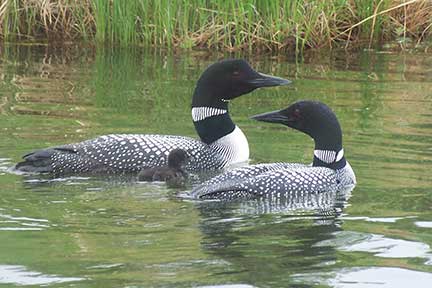 Loons at the Lake
Loons at the Lake
July 3 - 7, 2009
Loons nest on the island in our homestead lake every year. 2005 was the first year one of them let us approach. The female would not leave her nest for any reason. We floated nearby in a canoe and took pictures of her, including the one below.
In 2008, a chick surfaced right next to our canoe. The parents quickly retrieved him but didn't seem panicked or especially concerned. We hoped they would learn we wouldn't hurt them.
It is likely the same pair that nested on the south side of the island in 2009. The weather that July was calm and clear, which allowed me to sit in the canoe and videotape with a long lens. We saw the chick the very day it hatched, trying to climb onto its mama's back! Only one of two eggs hatched. The other was abandoned. The parents poured all their energy into the first chick.
Of all the videos I've put together, this is probably my favorite. The music is "Apogee" by Amy Shreve, from her album Peace in the Puzzle. Used by permission. Like it? Find it and more great music at www.amyshreve.com.
A few interesting facts about loons:
- The common loon is the state bird of Minnesota.
- Loons average 32" from bill tip to tail tip.
- They are highly territorial and prefer secluded lakes away from human activity. Generally no more than one pair of loons nests on a lake (unless it is a very large lake).
- Loons mate for life. If a loon dies, its mate spends the rest of its life alone.
- Chicks ride on their parents' backs and hang on even when the adult bird dives. Sometimes several chicks sit in a line on the same parent's back.
- Loons dive to catch fish.
- Common loons are among the deepest diving birds. They have been found underwater at depths of 160 feet. The pressure at that depth would be about 69 pounds per square inch. They can adjust the pressure inside their bodies and can swim at any level in the water, sometimes with their bodies below and just their heads above the waterline.
- Common loons have red eyes.

This was the first loon that allowed us to approach. We think she may have lost her first clutch of eggs. She refused to leave the nest when we first accidentally canoed nearby or at any time thereafter!
Notice how many mosquitos are feasting on her blood!
Go on to read Hunting with Kids
Source: www.SusanCAnthony.com, ©Susan C. Anthony
